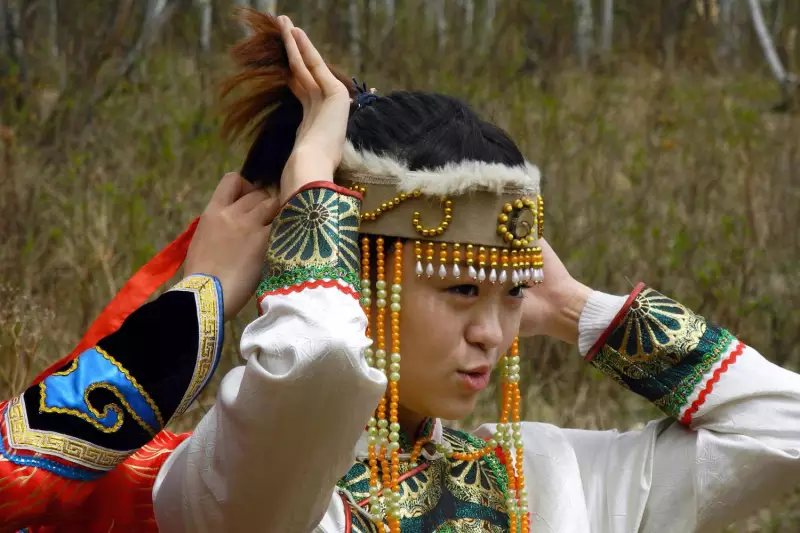The Oroqen people is one of the most populous nationalities in Northeast China. According to the fifth national census in 2000, the population of Oroqen is 8196. Oroqen language belongs to the Tungusic branch of Manchu Tungusic language family of Altaic language family. It has no characters, and now mainly uses Chinese.
The Oroqen people is mainly distributed in the Oroqen Autonomous Banner, Butha banner, Molidawa Daur Autonomous Banner of Hulunbuir League in Inner Mongolia Autonomous Region, and the counties of Huma, Xunke, Aihu, I, and Jiayin in the north of Heilongjiang Province. There are 3871 Oroqen people in Heilongjiang Province, accounting for 47% of the total Oroqen population; there are 3573 Oroqen people in Inner Mongolia Autonomous Region, accounting for 44%.
In the long-term hunting production and social practice, the Oroqen people have created rich and colorful spiritual culture, including oral creation, music, dance, plastic arts, and so on.

Religious belief
The Oroqen people believe in Shamanism with nature and animism. This kind of religion is closely combined with the unique primitive ideas of the nation. Their religious forms include nature worship, totem worship, and ancestor worship. “Shaman” (wizard) is the messenger between God and man. Shamanism believes in quite a lot of gods. The natural gods worshipped by the Oroqen people are sun god, moon god, big dipper star God, fire god, heaven God, earth God, wind god, rain god, Thunder God, water god, grass God, Mountain God, and so on. In addition to the worship of nature, the ancestors of Oroqen also worshipped the totems of “Niuniuku (bear)” and “Laomas (tiger)”. The Oroqen people taboo the names of bear and tiger, but called them “Baorikan (God)”, “Nuoyan (official)” and “Wutai (Master)”. The Oroqen people’s worship of their ancestors is very popular, and it is the same now.

Festival
There are not many traditional festivals of the Oroqen people, such as the Spring Festival, the “Mokun” meeting of the clan, the religious activity “Ominarene”, and the bonfire Festival. The main festival is the lunar new year.
In modern times, the social organization structure of the Oroqen people has undergone fundamental changes, and their religious beliefs have faded out of the Oroqen people’s thinking. “Mokun” Congress and “Ominarin” have been replaced by bonfire Festival. Influenced by other ethnic groups, the Oroqen people also celebrate Mid Autumn Festival, Dragon Boat Festival, new year, and other festivals. The Spring Festival is a happy day for Oroqen people to celebrate hunting harvest and welcome the new year. Therefore, Oroqen people attach great importance to the Spring Festival.
Every year, June 18 is the traditional festival of the Oroqen people – the bonfire Festival. On this day, the Oroqen people will light bonfires, sing, and dance, and celebrate their own national festivals.

Hunting
Hunting is the survival needs of the Oroqen people. They hunt in the vast forest all year round. Horse hunting and dog hunting are indispensable helpers for Oroqen hunters, known as “hunters’ partners”. For this special reason, the Oroqen people generally do not kill horses and dogs, nor eat horse meat and dog meat.
Diet
In the past, the diet of the Oroqen people was mainly animal meat, supplemented by fish and wild vegetables. Later, rice noodles were introduced. Oroqen people like to eat roe deer, deer, cudgel, wild boar, bear meat, but also eat small animals and flying birds. The main methods include cooking handlebar meat, barbecue, roast meat, stew soup, drying dried meat, cauliflower, perfusing serum, bone marrow oil, raw roe deer liver, and kidney, etc. Rice noodles mainly include noodles, oil noodles, pancakes, fried noodles, noodle soup, fried noodles with oil, porridge, thick plum porridge, sticky rice, and so on. In the Oroqen language, the oil noodle is called “tubules”. Pull the rolled noodles into the rolling white water one by one, remove them and mix them with seasonings such as cooked meat slices, salt, wild leek flowers. Pour in the heated boar oil or bear oil and mix them well before eating. Thick plum porridge is a kind of special eating method of Oroqen people. Put thick plum into porridge and boil it. It can be eaten when it is burst to pink color. It is colorful and delicious.

The Oroqen people like to drink Wuweizi soup and birch juice. Every spring in May and June cut a small hole in the birch root, birch juice will gush out, clear, sweet, and delicious. The Oroqen people also drink a birch pulp called “disease”, peel off the birch bark, and gently scrape off the Milky viscous SAP on the trunk with a hunting knife. It tastes sweet and refreshing.
Clothes & Accessories
The costumes of the Oroqen people also fully show the characteristics of the hunting people. The roe deer skin processed by women in Oroqen is strong, soft, and light. To adapt to the cold climate and hunting life, the roe deer fur clothes and caps created by women in Oroqen are unique and unique. Roe deer leather garment, which is called “Su en” in Oroqen dialect, mostly keeps the true color of roe deerskin and is sewn with roe deer tendons into fine threads. It is mostly a right-side skirt robe and decorated with “bow and scissors”, “antler” and “cloud roll” patterns, which is both beautiful and strong. The roe deer head cap of the Oroqen nationality looks like a roe deer head. It is vivid, lifelike, warm, and exquisite.










